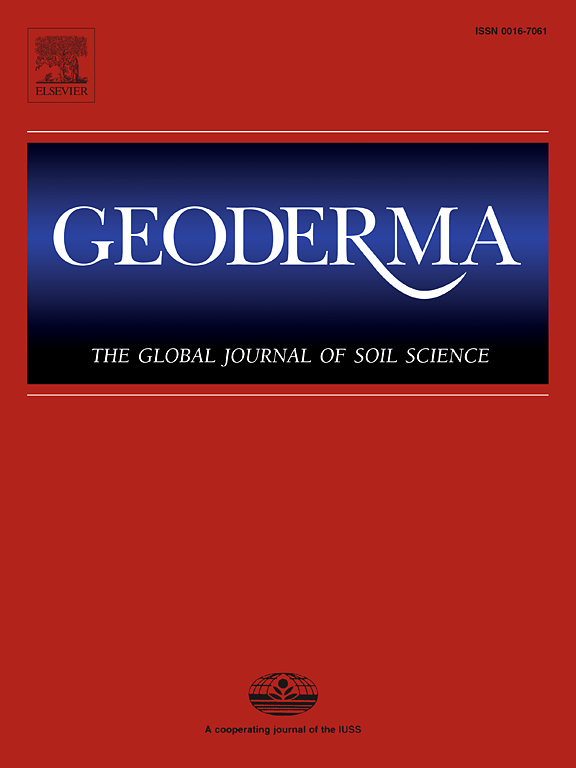Soil aggregate stability index independent from pre-stress aggregate size distribution: A test from soils affected by the water level fluctuation in the Three Gorges Reservoir, China
IF 5.6
1区 农林科学
Q1 SOIL SCIENCE
引用次数: 0
Abstract
Soil aggregate stability measurement is essential to determine soil health status under various conditions. The Mean Weight Diameter (MWD) is the most applied index to express aggregate stability particularly for wet and dry sieving. However, the MWD could generally present results affected by pre-stress aggregate size distribution when remained aggregates after stress are considered for calculation. Therefore, the objective of the present study was to eliminate the similarities between the MWD results and pre-stress aggregate size distribution, which largely affects treatments differentiation. Samples from 145-160 m (lower), 160–169 m (middle), and 169–175 m (upper) elevations differently affected by the Water Level Fluctuation in Three Gorges Reservoir (TGR) and control (>175 m) were exposed to wet shaking stress. Aggregates remained at each sieve opening, aggregates disintegrated/passed through the sieve opening, and small macroaggregates and microaggregates accumulated were recorded. These aggregates were used to determine and compare two indexes (1) using remained aggregates (MWD) and (2) using disintegrated/accumulated aggregates (MWDd/a) based on the differences among treatments. The results for both pre-stress aggregates and remained aggregates after stress were showed consistent significant differences (p < 0.05) between upper and control elevations. This gives indication that aggregates remained after stress strongly depend on pre-stress aggregate size distribution. As the MWD was calculated from remained aggregates, the identified difference between upper and control elevations for this index could also confirm its dependence to pre-stress aggregates distribution. Contrary, disintegrated and accumulated aggregates showed non-significant differences between upper and control elevations. This non-significant and significant differences between upper and control elevations for disintegrated and pre-stress aggregates suggest a non-dependence condition. Similarly, the upper and control elevations showed no significant differences in MWDd/a. This substantially informs that this index is independent from pre-stress aggregates distribution because it was entirely calculated from disintegrated aggregates. Higher aggregate stability was indicated by high MWD, with values ranging from 1.41 to 6.24 mm. On the other hand, higher stability was expressed by lower values of the MWDd/a, with the values varying between 3.87 and 0.5 mm. Overall, the present study evidenced the major advantage of considering the disintegrated/accumulated than remained aggregates in calculating unbiased MWD index for aggregate stability.
独立于应力前集料粒径分布的土壤集料稳定性指数:受中国三峡水库水位波动影响的土壤测试
土壤集料稳定性测量对于确定各种条件下的土壤健康状况至关重要。平均重量直径(MWD)是表示集料稳定性的最常用指标,尤其是在干湿筛分时。然而,当计算应力后的残余集料时,MWD 通常会受到应力前集料粒度分布的影响。因此,本研究的目的是消除 MWD 结果与应力前骨料粒度分布之间的相似性,因为这在很大程度上影响了处理方法的区分。受三峡水库(TGR)水位波动影响不同的 145-160 米(下层)、160-169 米(中层)和 169-175 米(上层)海拔样本以及对照组(>175 米)样本均暴露于湿振动应力下。记录了留在每个筛孔的集料、崩解/穿过筛孔的集料以及积累的小的大集料和微集料。根据不同处理之间的差异,用这些集料来确定和比较两个指数(1)使用残留集料(MWD)和(2)使用崩解/积聚集料(MWDd/a)。应力前集料和应力后残留集料的结果表明,上部海拔和对照海拔之间存在一致的显著差异(p < 0.05)。这表明,应力后的残留集料在很大程度上取决于应力前的集料粒度分布。由于 MWD 是根据残留集料计算得出的,因此该指数在上部海拔高度和对照海拔高度之间的差异也证实了其与应力前集料分布的相关性。与此相反,崩解集料和累积集料在上限和对照标高之间的差异并不显著。瓦解集料和应力前集料的上限与对照组上限之间的不显著差异和显著差异表明,两者之间不存在依赖关系。同样,上部标高和控制标高在 MWDd/a 方面也没有显著差异。这充分说明该指数与预应力集料的分布无关,因为它完全是根据崩解集料计算得出的。高 MWD 表示集料稳定性较高,其值在 1.41 至 6.24 毫米之间。另一方面,较低的 MWDd/a 值(介于 3.87 毫米和 0.5 毫米之间)也表示较高的稳定性。总之,本研究证明,在计算骨料稳定性的无偏 MWD 指数时,考虑崩解/堆积骨料比考虑残留骨料更有优势。
本文章由计算机程序翻译,如有差异,请以英文原文为准。
求助全文
约1分钟内获得全文
求助全文
来源期刊

Geoderma
农林科学-土壤科学
CiteScore
11.80
自引率
6.60%
发文量
597
审稿时长
58 days
期刊介绍:
Geoderma - the global journal of soil science - welcomes authors, readers and soil research from all parts of the world, encourages worldwide soil studies, and embraces all aspects of soil science and its associated pedagogy. The journal particularly welcomes interdisciplinary work focusing on dynamic soil processes and functions across space and time.
 求助内容:
求助内容: 应助结果提醒方式:
应助结果提醒方式:


